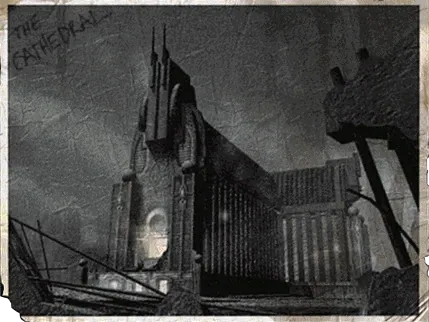
Hello Hivers and Book Clubbers,
Back again, hope you're all doing well. I took a small break from reading non-fiction by picking a novel that I had on my 'to-read' list for quite a while. The book in question is 'A Canticle for Leibowitz', written by Walter M. Miller. Originally published in English in 1959, I read it in English as well through a pdf-file.
How I heard of this book is a small story in itself. You might recognize the picture above, if you're a somewhat old-school gamer. It's 'the Cathedral', a location in Fallout 1, a PC role-playing game that came out in the late 1990s. To figure out the setting and atmosphere of those first two Fallout-games, the developers based it partly on several novels. One of those was this book, A Canticle for Leibowitz.
Setting and Motifs
Something that I'm not going to talk about in this review, is the actual story. That is something for potential readers to discover for themselves, and I'm not looking to spoil anything. Instead, I'll try to give you a feel for the setting, and recurring motifs throughout the book.
The book was written in 1959, during the Cold War. The overaching threat of that 'war', was the issue of nuclear weapons. Its ability to destroy cities in one swoop, as it did in 1945 in Hiroshima and Nagasaki, led to a distinct fear in the West (and in other places too, I'm sure). What if it goes wrong, and hundres of these weapons are used at once?
Miller makes this possibility a reality in A Canticle for Leibowitz. After a few pages the reader will figure it out: the world has been wrecked by a massive nuclear war. The place of the story is familiar and distant at the same time: the United States, or put more precisely, what's left of the United States.
And not much is left of it. The book starts at about 600 years after nuclear catastrophe (which is somewhere in the 1970s, so we're talking the 26th century), and humanity is struggling to survive. People are barely (or not) getting the basic necessities for life; food, shelter, etc. Buildings are mostly made from the rubble left by the old civilization.
Science v. Faith
Any vestige of culture or science has completely imploded. In fact, the opposite seemed to have happened in the first few centuries after the destruction; ignorance was deemed bliss. Since the old civilisation knew so much, why did it go wrong then? The answer they thought of was simple; better to be ignorant of all of it. So literacy completely imploded, science was abhorred, and humanity regressed to a sort of bronze age, with ruins that hinted at a more advanced past.
What has survived in a certain sense, is religion. It's a common occurrence in history: when times get rough, people tend to turn to (or fall back on) religion. And since times have gotten rough, there is good reason for it in this story. Christianity, more specifically Roman Catholicism, has survived, albeit in a changed way. There still is a Vatican, but now it is in America itself, in a place called 'New Rome'. Monks, priest, abbeys an cathedrals all exist, and they are very important places.
Their importance is similar to the role monasteries played in the European Middle Ages: back then, monks copied many works of Classical Antiquity, which have only survived today because of their work. The monks of the post-apocalypse do the same in the story. They saved whatever scraps of knowledge they could find or remember -though they don't understand the vast majority of it- and copy and repair these works.
Flash Forward
There are multiple skips in time, each skips counting to about six centuries. The focus of humanity changes along with it. After 600 more years, humanity had clearly progressed to a point where it slowly started to thrive again. For example: electricity and gunpowder were re-invented, and the picture of what happened to the earlier civilizations was becoming more clear.
Pass another 600 years, and humanity is conquering the stars, i.e. is technologically more advanced than it has ever been. This, of course, comes with its own drawbacks and challenges, which the book treats quite centrally in the story.
Conclusion
I hope I've given you enough context here, to be able to decide for yourself whether this might be a good read for you. I've been able to stay away from the story proper, and hope you give it a try. I've found it quite enjoyable. I'll be doing more book reviews in the future, though mostly non-fiction so far. I'll see you all in the next one.
-Pieter Nijmeijer
(Image sourced from here)